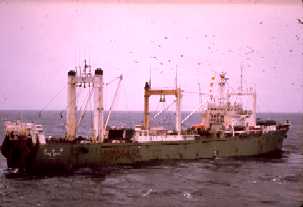Foreign Fishery
Japan initiated a fishery for yellowfin sole in the eastern Bering Sea in 1933.
This fishery continued until 1941 when it was terminated by the outbreak of World War II.
Japanese fishing vessels returned in 1954 and were joined in 1959 by fishing vessels from the former U.S.S.R.
During the 1950s and 1960s, the number of participating vessels increased and began targeting other species and
exploring new fishing areas. Flatfish were the
principal targets of the Japanese and Russian fleets during the '50s and '60s. By the
mid-1960s, after a decline in flatfish stocks, both Japan and Russia began targeting
walleye pollock. During the late 1960s and early 1970s vessels from other countries began
fishing in the eastern Bering Sea including; Taiwan, the Republic of Korea, and Poland.
 The National Marine Fisheries Service (NMFS) began placing observers on foreign fishing
vessels operating off the northwest and Alaskan coasts of the United States in 1973, creating the
North Pacific Foreign Fisheries Observer Program. Initially,
observers were placed on vessels only upon invitation by host countries. In the early
years of the program the primary purposes of observers were to determine incidental catch
rates of Pacific halibut in groundfish catches and to verify catch statistics in the
Japanese crab fishery. Later, observers collected data on the incidence of king crab, snow
(Tanner) crab, and Pacific salmon, and obtained biological data on other important
species. Following the implementation of the Magnuson Fishery Conservation and Management
Act of 1976, which mandated that foreign vessels accept observers, observer coverage
greatly expanded. The National Marine Fisheries Service (NMFS) began placing observers on foreign fishing
vessels operating off the northwest and Alaskan coasts of the United States in 1973, creating the
North Pacific Foreign Fisheries Observer Program. Initially,
observers were placed on vessels only upon invitation by host countries. In the early
years of the program the primary purposes of observers were to determine incidental catch
rates of Pacific halibut in groundfish catches and to verify catch statistics in the
Japanese crab fishery. Later, observers collected data on the incidence of king crab, snow
(Tanner) crab, and Pacific salmon, and obtained biological data on other important
species. Following the implementation of the Magnuson Fishery Conservation and Management
Act of 1976, which mandated that foreign vessels accept observers, observer coverage
greatly expanded.
In 1978 American fishers began fishing for groundfish in joint ventures with foreign
processing vessels. By 1986 all nonjoint-venture foreign fisheries were halted, and by
1991 all foreign fishing within the 200 mile Exclusive Economic Zone
(EEZ) of the Bering Sea and Gulf of Alaska was terminated.
Domestic Fishery
 NMFS began placing observers on domestic vessels in 1986. This was in support of an
industry-funded data gathering program on domestic vessels fishing in an
area of the Bering Sea north of Port Moller where bycatch of red king crab was of concern.
Other small-scale domestic observer programs were implemented during the late 1980s. NMFS began placing observers on domestic vessels in 1986. This was in support of an
industry-funded data gathering program on domestic vessels fishing in an
area of the Bering Sea north of Port Moller where bycatch of red king crab was of concern.
Other small-scale domestic observer programs were implemented during the late 1980s.
The 1988 amendments to the Marine
Mammal Protection Act (MMPA) required vessels in fisheries identified as having
frequent interactions with marine mammals to carry observers for 20-30 percent of their
fishing days. In August 1989 NMFS began placing observers aboard these vessels through
Federal funding. Also in 1989, the groundfish management plans for the Gulf of Alaska and
eastern Bering Sea were amended to establish mandatory observer coverage requirements for
vessels and plants involved in the groundfish fishery in these areas. Those amendments
require vessels 125 feet or longer to carry a NMFS-certified observer 100 percent of the
time while fishing for groundfish; vessels 60-124 feet long to carry a
NMFS-certified observer during 30 percent of their fishing days in each calendar quarter of the year in
which they fish more than 10 days; plants processing 1,000 or more metric tons in a month
to have an observer in the plant each day they process groundfish; and those processing
500-1,000 metric tons to have observers 30 percent of the days.
The North Pacific Groundfish Observer Program was implemented in early 1990. Under this
program, NMFS provides the operational oversight of the program, certification training,
definition of observer sampling duties and methods, debriefing of observers, and
management of the data. Although the vessel and plant owners pay for the cost of the
observers, the costs associated with managing the program are covered by the Federal
Government.
|